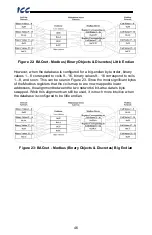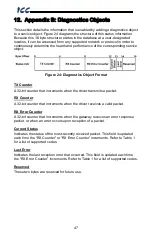
33
ICC
•
The
Cosine
operation calculates the expression
cos(Input 1)
, where
Input1
is
in radians.
•
The
Tangent
operation calculates the expression
tan(Input 1)
, where
Input1
is in radians.
•
The
Arc
Sine
operation calculates the expression
sin
-1
(Input 1)
, where the
output is in radians.
•
The
Arc
Cosine
operation calculates the expression
cos
-1
(Input 1)
, where
the output is in radians.
•
The
Arc
Tangent
operation calculates the expression
tan
-1
(Input 1)
, where
the output is in radians.
Filtering Operations
•
The
Debounce Filter
and
Hysteresis Filter
operations are functionally
identical with the single exception that the
Debounce Filter
does not use a
“Value Tolerance” (it is fixed at 0).
•
In order for the output of the
Debounce Filter
or
Hysteresis Filter
to change
(i.e. reflect the input value), “Input 1” must first change to a value outside of
the “Value Tolerance” range and then must remain within the “Value
Tolerance” range of the new value for the entire “Stable Time”.
8.3.2.2
Database Logic Settings
Scan Rate
Defines the scan cycle time in milliseconds (50ms minimum) of the database
logic processing task. All operations are evaluated for execution in sequential
order at this frequency. Note that this does not necessarily mean that each
operation is guaranteed to execute every scan cycle: only that it will be evaluated
as to whether or not it should execute. Namely, if an “Enable Trigger” element is
added to an operation, then the trigger must evaluate to “true” for the operation to
execute during that scan cycle. Refer to section 8.3.2.3 for more information on
Enable Trigger behavior.
8.3.2.3
Enable Trigger
Each database logic operation can optionally include an “Enable Trigger”
element, which provides dynamic conditional execution capabilities. By default
(i.e. if an enable trigger element is not added to the operation), each operation is
automatically triggered to execute every scan cycle. If it is desired for an
operation to execute conditionally, however, then an enable trigger element can
be added to it. The enable trigger element defines an “Enable Value”, which
specifies a byte-size trigger value that can reside at any location in the internal
database. When implemented, the enable value is evaluated every scan cycle: if
this value is non-zero (or zero when the “Inverted” Trigger Option is used), the
operation will execute.
The enable value itself can be modified by any communication driver currently
running on the device, which enables networked devices to dynamically control
the execution of database logic operations. The enable value can also be the
output result of other database logic operations. While the output of any






























